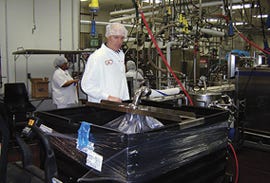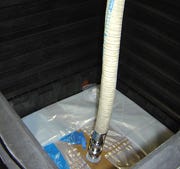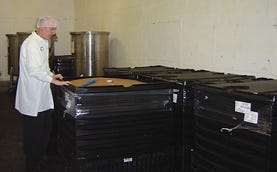Bulk containers are 'pack-friendly' to ice cream toppings
February 4, 2014

Easier to maintain, fill and empty, the patented, 330-gal IBCs are pratically hands-free. The system works by replacing the volume of liquid pumped out of an inner chamber of the bag liner with shop air introduced to chambers on the outside of the bag. This forces the liquid in the bag to the bag's outlet.
Friendly Ice Cream Corp. (Friendly's for short), Wilbraham, MA, says it has found the cherry on the banana split as far as its warehousing and packaging operation is concerned. The company makes fudge and pineapple toppings in 600-gal kettles.
Recently, it was able to improve safety and sanitation and decrease manual labor, as a result of converting to the Air-Evac(R) intermediate bulk container (IBC) system from A.R. Arena Products (www.arenaproducts.comS) from stainless-steel tanks. At its production plant in Wilbraham, Friendly's has been successfully using the bulk containers to handle its high-viscosity ice-cream toppings for a bit more than a year.
Friendly's is a vertically integrated restaurant company serving the East Coast with signature sandwiches, entrées and ice cream desserts in a family environment in more than 515 company and franchised restaurants throughout the Northeast. The company also manufactures ice cream distributed through more than 4,500 supermarkets and other retail locations. With a 71-year operating history, Friendly's enjoys strong brand recognition and is currently revitalizing its restaurants and introducing new products to grow its customer base.
Previously, Friendly's pumped the toppings from the kettles into 250-gal stainless-steel tanks. Once filled, the tanks were placed in storage and then moved out to various work centers when needed to incorporate additional, thick ingredients into the toppings.
"The stainless-steel tanks were large and took up a lot of storage space," admits Jim Perry, business unit supervisor at the plant. The tanks had to be moved manually out to the work centers. "Their wheels would occasionally get stuck in floor drains, and they were difficult to move. Safety is a very important issue for Friendly's," he adds

In addition, considerable manual labor was required to scrape out and offload the viscous contents into the finished-product containers. Cleaning the tanks was also a labor-intensive process, Perry says, as the tanks had to be washed and sanitized properly to prevent contamination. Once they were emptied and cleaned, the tanks were stored until needed again but they had to be cleaned a second time before filling.
Friendly's says it made attempts to try other IBCs, but that it couldn't find any that were able to evacuate as much product as Friendly's would have liked. Most produced higher residual levels.
Then, members of the company's manufacturing team saw the Air-Evac System at a trade show and noticed that the patented system, teamed with Arena's 330 Shipper(TM), which holds up to 330 gal, is hands-free and is quite different from many conventional methods of emptying liquid from bag-in-box liners. The system works by replacing the volume of liquid pumped out of an inner chamber of the bag liner with shop air introduced to chambers on the outside of the bag. This forces the viscous liquid in the bag to the bag's outlet. Air volume is increased as the liquid content decreases. As the product pools around the drain opening, it can easily be pumped out, enabling the Air-Evac to achieve low residual levels. The inflating Air Evac liner alerts operators when the contents of the bag are nearly emptied, as the bag begins to expand above the top of the shipper.
For more information about A.R. Arena's IBCs and Air-Evac system, visit www.packagingdigest.com/ info/arena
According to Arena, residual levels can be reduced by more than half, as the Air-Evac eliminates the need to wring out the bag liner or scrape out residual contents, like Friendly's previously did with the former tanks, while reducing the environmental impact of solid waste.
With a snap-on cover, replaceable skid pads, a 2- or 3-in. bottom discharge and four-way forklift entry, the outer reusable container (IBC) is made of what Arena says is a proprietary, all-plastic construction of advanced, structural plastic resins and composites. The container collapses for return shipping and storage. Since the system doesn't require operator intervention or monitoring, Friendly's finds it can dramatically reduce waste and increase product yield.
The flexible but sturdy polyethylene film bag liner can be furnished with one to three plies in a range of thicknesses, depending on the application, with or without product barriers to accommodate many different products. Equipped with one valve centered on its top and another in a bottom corner, the three-ply version Friendly's uses is designed to fit a variety of IBCs.
Use of the IBC begins at each of Friendly's work centers where the company currently uses the BlowFish Air-Evac liner—designed for bottom-discharge applications—and the 330 Shipper, one of Arena's newest liquid storage/shipper combinations. Friendly's pumps the toppings from the kettles into the Air-Evac liner bags, which hold a net capacity of about 300 gal each (net capacity varies slightly, based on the bag configuration and other factors).
The drop-in Blowfish liner bag cassette, nestled in the outer shipper, is then stored in an anteroom. When needed, the Arena shippers are easily and safely delivered to the work company's centers using a pallet jack.

Friendly's new containers help eliminate solid waste and its environmental impact.
At the work center, an operator removes the shipper's cover and connects the Blowfish bag to a pump. A central air supply is introduced to the bag chambers on the outside lining of the bag through an air regulator.
The operator connects the air-delivery system to an inflation tube and turns on the integrated air valve. As the product pumps out, the automatic air-delivery system replaces product volume with regulated air, inflating the air chamber in the Air-Evac bag.
The bag pops out of the shipping tote when the product is nearly empty. When the Air Evac bag is fully inflated, the air-delivery system shuts off automatically. At this point, the amount of product left in the bag is at a minimum, Friendly's explains. After the inflation tube is removed from the air-delivery system, the Air-Evac air chamber can be pierced to speed deflation, and the liner can be removed from the outer container and discarded. The 330 Shipper can then be collapsed for return shipment
When the bag is emptied, it is thrown away. The shipper can be easily collapsed, stacked and stored until needed again. The shippers are cleaned and sanitized before each use.
"Safety is number-one at Friendly's ,and the Arena system has eliminated the potential safety hazards," summarizes Perry. "We've also improved sanitation and decreased our manual labor. We are very pleased with the system."
Friendly's is also testing the Arena Starfish(R) Air-Evac system, which incorporates a top-discharge pumping system to further enhance safety and sanitation and reduce residual levels. Even sweeter, the company is introducing new products to grow its customer base.
More information is available:
A.R. Arena Products, 800/836-2528. www.arenaproducts.com.
About the Author(s)
You May Also Like


